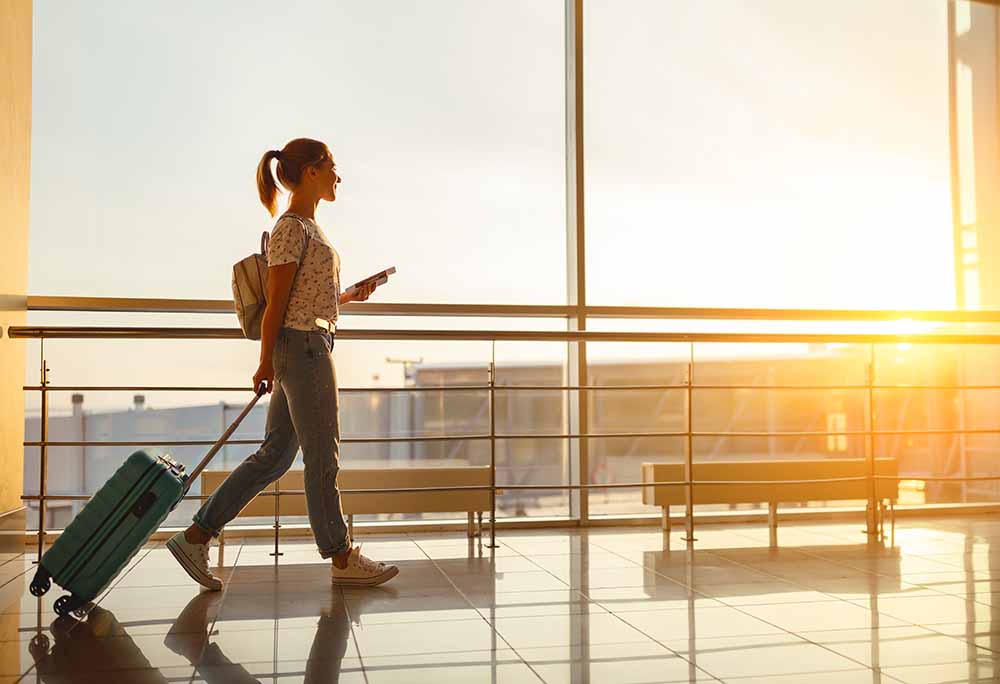
Air travel seems easy in theory. It’s often the fastest way to get around and, with someone else in charge of the plane, you can just sit back and relax, watch a movie, read a book, or even take a nap. However, these days especially, air travel isn’t exactly stress-free. With so many rules and regulations, it’s hard to know what to expect and what to be aware of if you aren’t a frequent flier. Here are a few air travel restrictions to keep in mind for your next flight.
When to arrive at the airport Overweight luggage Carry-on only items Cell phone use in the sky
When to arrive at the airport
People tend to go one of two ways when it comes to airport arrival time: they either want to be early to give themselves lots of time, or they go later to avoid waiting around. Since COVID-19, airports tend to be a little slower, with many airlines asking guests to come three or four hours early depending on the airport and route. That being said, there’s such a thing as going too early – in which case the check-in counter will not yet be open for your flight.
On the same note, you don’t want to leave it too late either, especially if you’re checking luggage. Every airline will have a checked luggage cut-off time, and usually that’s about an hour before your flight. Your best bet is to follow the suggested timeline given by the airline.
Overweight luggage
One of the most common jokes when it comes to travel revolves around
As a traveller, it seems like the weight restrictions are in regards to what the plane can manage. While there are weight limitations for flights, the rules are primarily for the employees who handle your luggage. Overweight luggage is considered to have more of a risk for an injury. This is why airlines have weight limits on individual bags both for checked and carry-on luggage. You’ll notice if a checked bag is overweight, it will be marked as such at the check-in counter; this is to alert the baggage handlers so that they can plan accordingly.
Airlines differ in their luggage allowances, so read up ahead of time. It may also be worth investing in a small luggage scale to have on hand when packing to ensure that you stay within the weight limits.
Carry-on only items
When you check in online or at the counter, you will be asked if you have certain items in your suitcase. This includes things like valuables and money, which are safer kept with you in case your luggage gets lost or damaged, or in rare cases stolen.
You will also see notes about devices with lithium batteries. These are found in common devices such as cameras, tablets, smartphones, and power banks. The reason they are prohibited in checked luggage is because if they get damaged, they could become a fire hazard. Of course, they could become damaged in the cabin as well as in the luggage hold, but it’s a lot easier to see - and put out - a potential fire in the cabin. So when packing, make sure to check the list of cabin-only items ahead of time - that way you don’t have to worry about rearranging your baggage at the airport.
Cell phone use in the sky
Finally, cell phone use in the sky: Every airline will tell you to put your phone into airplane mode before take-off and only to turn it back on after handling. This is because, even when far away from cellphone towers, your phone will still try to connect. Those electronic signals can impact aircraft instruments including communication.
Does this mean that if one or two people forget to switch off their phones, the plane is going to drop from the sky? No. There would need to be a number of devices still turned on and sending out signals to have a real impact, and the flight crew would be able to tell based on the feedback on their equipment and rectify the problem. But, in order to keep things simple, just turn your phone onto airplane mode when asked. Not only does it make the flight crew’s job easier, but it also will save on any accidental roaming fees!
There’s a lot to know these days when it comes to flying, but updated information is readily available online with a quick search. Keep in mind that every airport and airline is different, so when it comes to things like baggage allowances and even airport security, you might notice differences depending on where you are. It’s important to refer to the specific airline you are flying with and look for signs (or ask questions) at the airport.
Hannah Logan is a Canadian travel writer who dreams of being just like Indiana Jones. You can follow her travels on her personal travel blog
Eat Sleep Breathe Travel where she shares her travel tales and (mis)adventures around the world.